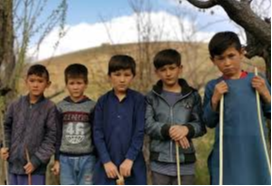The History of the Hazara People

May 24, 2022
The Hazara people aren’t talked about enough. The things they had to go through in their own country, how most are strangers to their homeland, and how the people have spent their lives being refugees. Some Hazara people don’t even like the idea of living in their primary country! I mean, who wouldn’t want to live in the country their ancestors were harassed in? Oppressed in? Or forced out of?
The Hazara people originate from a country called Afghanistan in Southern Asia. Among the many tribes that they lived with, the Afghani people were perhaps the most prominent. Not only was their population high in numbers, they were also the antagonists to the Hazara people’s stories. The most obvious difference between the Afghani people and the Hazara people goes back 1500 years ago to when Prophet Muhammad (pbuh) died. After his death, the Sunni people appointed a Caliph (the chief Muslim or religious ruler) of their own, and the Shia people accepted the Caliph that the Prophet wished to replace him after his death.
Also important to remember is the fact that most Afghani people are Sunni, and most of the Hazara people are Shia. While the latter group does not care much about their differences, the Afghani people voice their dislike towards the Hazara people freely and frequently, or at least they used to.
Their history began in the late 1800s, when the Prime Minister of Afghanistan at the time started to persecute the Hazara people. This ethnic minority group were executed in front of their families, women were enslaved and men were put in jail for no reason but their ethnicity.
Fearing for their lives and with no other choice, the remaining Hazara people fled their homes and moved out to neighboring countries like Iran and Pakistan. Our ancestors unwillingly left their homeland and had to go through all the hardships of rebuilding life for themselves and for their families in a country they weren’t familiar with. That, on its own, brings a myriad of challenges. And it wasn’t even one family, the Afghani people did this to countless innocent Hazaras!
The long lasting hostility between the Afghani and the Hazara people has now died down, but let’s not forget the cost of their aggressiveness all those years ago: the Hazara people were displaced from their homes, and forced to raise their upcoming generations in countries they didn’t belong in. None dared to move back to Afghanistan in fear of the past. So, they all continued living where they were brought.
In my previous article, “Afghanistan: A Game of Dominoes”, I mentioned that the terrorists are against Shia poeple. To elaborate, they enjoy “Hazara Target Killing,” a term that has evolutionized over the decades because that’s how long the Hazara people have been a target. This time around, the terrorists were the ones that highlighted their hatred by targeting the Hazara people in the countries that had previoulsy escaped to: places which buzzed with innocent Hazaras, parks that were frequently visited by Hazara families, and bazaars that homed Hazara merchants were all mercilessly bombed.
Therefore, the new generations of Hazara people fled their newly built homes in fear of their lives once again. Especially families with children because parents refused to raise their kids in a vicious environment like the one they were in. Such families became refugees in foreign countries like Australia, the U.S, New Zealand, Canada and more. Soon a new round of generational immigration began.
With the new generations of Shia Muslims in foreign countries, they are distant with their tradition, culture and even religion. The parents managed to escape death, but now they are stuck with children who don’t understand their origins… So many problems, all because the Afghani people couldn’t bear the thought of diversity.